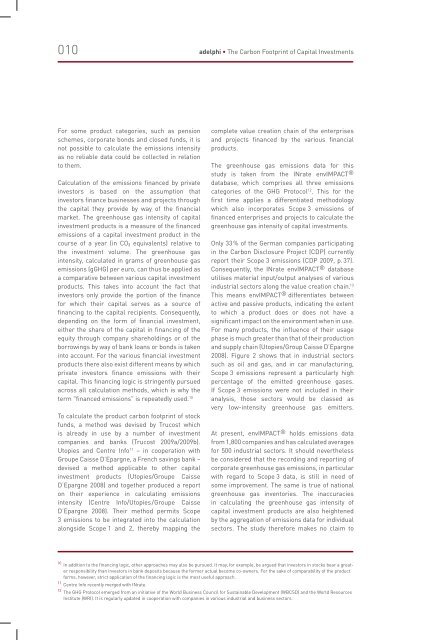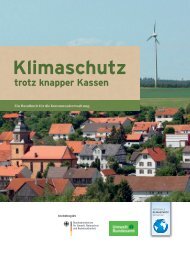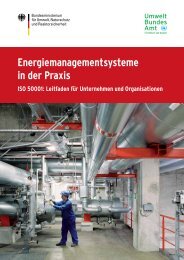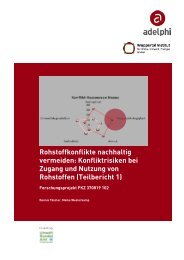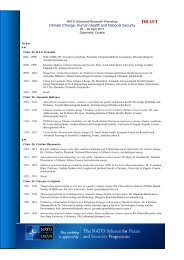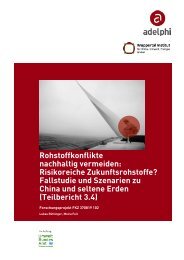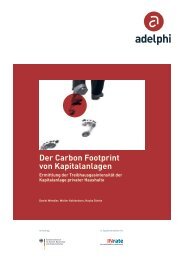The Carbon Footprint of Capital Investments - adelphi
The Carbon Footprint of Capital Investments - adelphi
The Carbon Footprint of Capital Investments - adelphi
You also want an ePaper? Increase the reach of your titles
YUMPU automatically turns print PDFs into web optimized ePapers that Google loves.
010 <strong>adelphi</strong> • <strong>The</strong> <strong>Carbon</strong> <strong>Footprint</strong> <strong>of</strong> <strong>Capital</strong> <strong>Investments</strong> <strong>adelphi</strong> • <strong>The</strong> <strong>Carbon</strong> <strong>Footprint</strong> <strong>of</strong> <strong>Capital</strong> <strong>Investments</strong><br />
011<br />
Figure 2: Average breakdown <strong>of</strong> the greenhouse gas intensities <strong>of</strong> various industrial sectors<br />
For some product categories, such as pension<br />
schemes, corporate bonds and closed funds, it is<br />
not possible to calculate the emissions intensity<br />
as no reliable data could be collected in relation<br />
to them.<br />
Calculation <strong>of</strong> the emissions financed by private<br />
investors is based on the assumption that<br />
investors finance businesses and projects through<br />
the capital they provide by way <strong>of</strong> the financial<br />
market. <strong>The</strong> greenhouse gas intensity <strong>of</strong> capital<br />
investment products is a measure <strong>of</strong> the financed<br />
emissions <strong>of</strong> a capital investment product in the<br />
course <strong>of</strong> a year (in CO 2 equivalents) relative to<br />
the investment volume. <strong>The</strong> greenhouse gas<br />
intensity, calculated in grams <strong>of</strong> greenhouse gas<br />
emissions (gGHG) per euro, can thus be applied as<br />
a comparative between various capital investment<br />
products. This takes into account the fact that<br />
investors only provide the portion <strong>of</strong> the finance<br />
for which their capital serves as a source <strong>of</strong><br />
financing to the capital recipients. Consequently,<br />
depending on the form <strong>of</strong> financial investment,<br />
either the share <strong>of</strong> the capital in financing <strong>of</strong> the<br />
equity through company shareholdings or <strong>of</strong> the<br />
borrowings by way <strong>of</strong> bank loans or bonds is taken<br />
into account. For the various financial investment<br />
products there also exist different means by which<br />
private investors finance emissions with their<br />
capital. This financing logic is stringently pursued<br />
across all calculation methods, which is why the<br />
term "financed emissions" is repeatedly used. 10<br />
To calculate the product carbon footprint <strong>of</strong> stock<br />
funds, a method was devised by Trucost which<br />
is already in use by a number <strong>of</strong> investment<br />
companies and banks (Trucost 2009a/2009b).<br />
Utopies and Centre Info 11 – in cooperation with<br />
Groupe Caisse D’Epargne, a French savings bank –<br />
devised a method applicable to other capital<br />
investment products (Utopies/Groupe Caisse<br />
D‘Epargne 2008) and together produced a report<br />
on their experience in calculating emissions<br />
intensity (Centre Info/Utopies /Groupe Caisse<br />
D’Epargne 2008). <strong>The</strong>ir method permits Scope<br />
3 emissions to be integrated into the calculation<br />
alongside Scope 1 and 2, thereby mapping the<br />
complete value creation chain <strong>of</strong> the enterprises<br />
and projects financed by the various financial<br />
products.<br />
<strong>The</strong> greenhouse gas emissions data for this<br />
study is taken from the INrate envIMPACT®<br />
database, which comprises all three emissions<br />
categories <strong>of</strong> the GHG Protocol 12 . This for the<br />
first time applies a differentiated methodology<br />
which also incorporates Scope 3 emissions <strong>of</strong><br />
financed enterprises and projects to calculate the<br />
greenhouse gas intensity <strong>of</strong> capital investments.<br />
Only 33 % <strong>of</strong> the German companies participating<br />
in the <strong>Carbon</strong> Disclosure Project (CDP) currently<br />
report their Scope 3 emissions (CDP 2009, p. 37).<br />
Consequently, the INrate envIMPACT® database<br />
utilises material input/output analyses <strong>of</strong> various<br />
industrial sectors along the value creation chain. 13<br />
This means envIMPACT® differentiates between<br />
active and passive products, indicating the extent<br />
to which a product does or does not have a<br />
significant impact on the environment when in use.<br />
For many products, the influence <strong>of</strong> their usage<br />
phase is much greater than that <strong>of</strong> their production<br />
and supply chain (Utopies/Group Caisse D’Epargne<br />
2008). Figure 2 shows that in industrial sectors<br />
such as oil and gas, and in car manufacturing,<br />
Scope 3 emissions represent a particularly high<br />
percentage <strong>of</strong> the emitted greenhouse gases.<br />
If Scope 3 emissions were not included in their<br />
analysis, those sectors would be classed as<br />
very low-intensity greenhouse gas emitters.<br />
At present, envIMPACT® holds emissions data<br />
from 1,800 companies and has calculated averages<br />
for 500 industrial sectors. It should nevertheless<br />
be considered that the recording and reporting <strong>of</strong><br />
corporate greenhouse gas emissions, in particular<br />
with regard to Scope 3 data, is still in need <strong>of</strong><br />
some improvement. <strong>The</strong> same is true <strong>of</strong> national<br />
greenhouse gas inventories. <strong>The</strong> inaccuracies<br />
in calculating the greenhouse gas intensity <strong>of</strong><br />
capital investment products are also heightened<br />
by the aggregation <strong>of</strong> emissions data for individual<br />
sectors. <strong>The</strong> study therefore makes no claim to<br />
3,500<br />
3,000<br />
2,500<br />
2,000<br />
1,500<br />
1,000<br />
500<br />
0<br />
2,849<br />
Oil and gas<br />
331<br />
Electricity companies<br />
Source: envIMPACT ® , INrate<br />
566<br />
1,965<br />
291<br />
be able to deliver entirely precise figures. <strong>The</strong><br />
basic message provided by the calculations is not<br />
decisively influenced by the inaccuracies however.<br />
Most especially, the comparison <strong>of</strong> investment<br />
products within the individual product categories<br />
set out in the following remains valid.<br />
Double counting <strong>of</strong> emissions within individual<br />
products is avoided. This happens where, for<br />
example, car manufacturers and oil producers<br />
are listed in the same fund. <strong>The</strong> emissions <strong>of</strong><br />
the fuels produced by the oil companies would<br />
then be counted double when calculating the<br />
emissions arising in use <strong>of</strong> the vehicles. To avoid<br />
this, the duplicate emissions within an investment<br />
product are cancelled out. As a result, the Scope 3<br />
emissions financed by financial investments can be<br />
collated without producing an unrealistically high<br />
figure due to multiple counting. However, based<br />
on the current methodology applied when creating<br />
average capital investment portfolios, double<br />
counts between different product categories<br />
cannot be entirely avoided. Consequently, with<br />
regard to the overall portfolio it is a fact that<br />
the absolute carbon footprint figures for capital<br />
investment portfolios include double counts which<br />
cannot be precisely stated.<br />
Airlines<br />
Car manufacturers<br />
Building materials<br />
manufacturers<br />
634 400 50<br />
Semiconductor<br />
manufacturers<br />
Food producers<br />
IT service providers<br />
Scope 1<br />
Scope 2<br />
Scope 3<br />
In calculating the carbon footprint, the study<br />
records the emissions financed by the investor<br />
or lender pro rata along the entire value creation<br />
chain. For the sake <strong>of</strong> transparency, an industrywide<br />
consensus should be found with regard to<br />
system limits in determining the carbon footprint<br />
<strong>of</strong> capital investment products.<br />
10 In<br />
addition to the financing logic, other approaches may also be pursued. It may, for example, be argued that investors in stocks bear a greater<br />
responsibility than investors in bank deposits because the former actual become co-owners. For the sake <strong>of</strong> comparability <strong>of</strong> the product<br />
forms, however, strict application <strong>of</strong> the financing logic is the most useful approach.<br />
11 Centre Info recently merged with INrate.<br />
12 <strong>The</strong><br />
GHG Protocol emerged from an initiative <strong>of</strong> the World Business Council for Sustainable Development (WBCSD) and the World Resources<br />
Institute (WRI). It is regularly updated in cooperation with companies in various industrial and business sectors.<br />
13 envIMPACT ® utilises input/output analysis data from the Green Design Institute at Carnegie Mellon University in Pittsburgh (comprising<br />
426 business sectors and recording the emissions data <strong>of</strong> 50 greenhouse gases) as well as the life cycle inventory (LCI) <strong>of</strong> industrial systems<br />
from the ecoinvent database and the life cycle assessment (LCA) data <strong>of</strong> specific products (e.g. <strong>The</strong> International Journal <strong>of</strong> Life Cycle Assessment).


